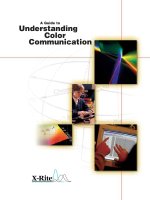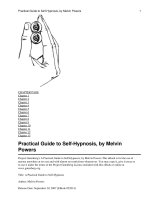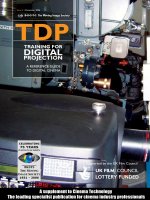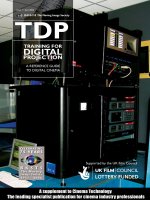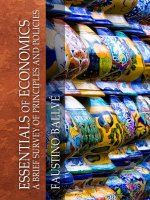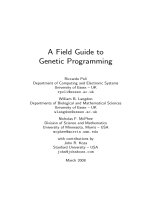A Brief Illustrated Guide to Understanding Islam pdf
Bạn đang xem bản rút gọn của tài liệu. Xem và tải ngay bản đầy đủ của tài liệu tại đây (4.82 MB, 80 trang )
Front Cover Photo:
Back Cover Photo:
More than one million Muslims from
all over the world praying together at
the Haram Mosque in Makkah.
The Prophet Muhammad’s Mosque
in Madinah.
For this entire book online, for more information
on Islam, or for a printed copy, visit:
www.islam-guide.com
I. A. Ibrahim
ILLUSTRATED GUIDE TO
ABRIEF
UNDERSTANDING ISLAM
Dr. William (Daoud) Peachy
Michael (Abdul-Hakim) Thomas
Tony (Abu-Khaliyl) Sylvester
Idris Palmer
Jamaal Zarabozo
Ali AlTimimi
General Editors
Professor Harold Stewart Kuofi
Professor F. A. State
Professor Mahjoub O. Taha
Professor Ahmad Allam
Professor Salman Sultan
Associate Professor H. O. Sindi
Science Editors
A
Brief Illustrated Guide To Understanding Islam
In the Name of God, the Most Gracious, the Most Merciful
Darussalam
Houston
Second Edition
Contents
Copyright
Copyright © 1997, 1996 I. A. Abu-Harb.
All rights reserved. No part of this book may be reproduced or transmitted
in any form or by any means, electronic, mechanical, including photocopy,
recording, or any information storage and retrieval system, without permission
in writing from the author, except for the situation below which is permitted.
For Reprinting
Reprinting or reproducing this book as a whole on the condition that
absolutely no change, addition, or omission is introduced is permitted free of
charge. To make high quality reprints,you may contact the authorto obtain free
copies of the computer print files of this book (address on page 70).
The Web Site of This Book
This entire book, as well as more information on Islam, is available online at:
www.islam-guide.com
2nd Edition - 3rd Printing
Library of Congress Catalog Card Number: 97-67654
ISBN: 9960-34-011-2
Published by Darussalam, Publishers and Distributors, Houston, Texas, USA.
A
Brief Illustrated Guide To Understanding Islam
(1) The Scientific Miracles in the Holy Qur’an . . . . . . . . . . 5
A) The Qur’an on Human Embryonic Development . . 6
B) The Qur’an on Mountains . . . . . . . . . . . . . . . . . . . 11
C) The Qur’an on the Origin of the Universe . . . . . . 14
D) The Qur’an on the Cerebrum . . . . . . . . . . . . . . . . 16
E) The Qur’an on Seas and Rivers. . . . . . . . . . . . . . . 17
F) The Qur’an on Deep Seas and Internal Waves . . . 20
G) The Qur’an on Clouds. . . . . . . . . . . . . . . . . . . . . . 22
H) Scientists’ Comments on the Scientific Miracles
in the Holy Qur’an . . . . . . . . . . . . . . . . . . . . . . . . 27
(2) The Great Challenge to Produce One Chapter Like the
Chapters of the Holy Qur’an . . . . . . . . . . . . . . . . . . . . 32
(3) Biblical Prophecies on the Advent of Muhammad r,
the Prophet of Islam . . . . . . . . . . . . . . . . . . . . . . . . . . . 33
(4) The Verses in the Qur’an That Mention Future Events
Which Later Came to Pass . . . . . . . . . . . . . . . . . . . . . . 35
(5) Miracles Performed by the Prophet Muhammad r . . . 36
(6) The Simple Life of Muhammad r . . . . . . . . . . . . . . . 37
(7) The Phenomenal Growth of Islam . . . . . . . . . . . . . . . . 40
(1) The Door to Eternal Paradise . . . . . . . . . . . . . . . . . . . . 41
(2) Salvation from Hellfire. . . . . . . . . . . . . . . . . . . . . . . . . 42
(3) Real Happiness and Inner Peace . . . . . . . . . . . . . . . . . 43
(4) Forgiveness for All Previous Sins . . . . . . . . . . . . . . . . 44
Chapter 1
Chapter 2
contents
Contents
some benefits of islam . . . . . . . . . . . . . . 41
Some evidence for the truth of islam . 5
TITLE PAGE
PREFACE . . . . . . . . . . . . . . . . . . . . . . . . . . . . . . 3
A
Brief Illustrated Guide To Understanding Islam
1
Save
What Is Islam? . . . . . . . . . . . . . . . . . . . . . . . . . . . . . . . . . . 45
Some Basic Islamic Beliefs . . . . . . . . . . . . . . . . . . . . . . . . 45
1) Belief in God . . . . . . . . . . . . . . . . . . . . . . . . . . . . . 45
2) Belief in the Angels . . . . . . . . . . . . . . . . . . . . . . . . 47
3) Belief in God’s Revealed Books . . . . . . . . . . . . . . 48
4) Belief in the Prophets and Messengers of God . . . 48
5) Belief in the Day of Judgment . . . . . . . . . . . . . . . . 48
6) Belief in Al-Qadar . . . . . . . . . . . . . . . . . . . . . . . . . 48
Is There Any Sacred Source Other than the Qur’an? . . . . . 49
Examples of the Prophet Muhammad’s r Sayings . . . . . . 49
What Does Islam Say about the Day of Judgment? . . . . . . 50
How Does Someone Become a Muslim? . . . . . . . . . . . . . . 52
What Is the Qur’an About?. . . . . . . . . . . . . . . . . . . . . . . . . 54
Who Is the Prophet Muhammad r? . . . . . . . . . . . . . . . . . . 54
How Did the Spread of Islam Affect the Development of
Science? . . . . . . . . . . . . . . . . . . . . . . . . . . . . . . . . . . . . 56
What Do Muslims Believe about Jesus? . . . . . . . . . . . . . . 57
What Does Islam Say about Terrorism?. . . . . . . . . . . . . . . 59
Human Rights and Justice in Islam . . . . . . . . . . . . . . . . . . 61
What Is the Status of Women in Islam? . . . . . . . . . . . . . . . 63
The Family in Islam . . . . . . . . . . . . . . . . . . . . . . . . . . . . . . 64
How Do Muslims Treat the Elderly? . . . . . . . . . . . . . . . . . 64
What Are the Five Pillars of Islam? . . . . . . . . . . . . . . . . . . 65
1) The Testimony of Faith . . . . . . . . . . . . . . . . . . . . . 65
2) Prayer. . . . . . . . . . . . . . . . . . . . . . . . . . . . . . . . . . . 66
3) Giving Zakat (Support of the Needy) . . . . . . . . . . 66
4) Fasting the Month of Ramadan . . . . . . . . . . . . . . . 67
5) The Pilgrimage to Makkah . . . . . . . . . . . . . . . . . . 67
Islam in the United States. . . . . . . . . . . . . . . . . . . . . . . . . . 68
For More Information on Islam . . . . . . . . . . . . . . . . . . . . . 69
For Suggestions and Comments on This Book . . . . . . . . . 70
For Further Reading on Islam. . . . . . . . . . . . . . . . . . . . . . . 70
References . . . . . . . . . . . . . . . . . . . . . . . . . . . . . . . . . . . . . 71
Contents
Chapter 3
general information on Islam. . . . . . . 45
A
Brief Illustrated Guide To Understanding Islam
2
This book is a brief guide to understanding Islam. It consists
of three chapters.
The first chapter, “Some Evidence for the Truth of Islam,”
answers some important questions which some people ask:
§
Is the Qur’an truly the literal word of God, revealed by Him?
§
Is Muhammad r
1
truly a prophet sent by God?
§
Is Islam truly a religion from God?
In this chapter, six kinds of evidence are mentioned:
1) The Scientific Miracles in the Holy Qur’an: This section
discusses (with illustrations) some
recently discovered scientific
facts mentioned in the Holy
Qur’an, which was revealed
fourteen centuries ago.
2) TheGreat ChallengetoPro-
duce One Chapter Like the
Chapters of the Holy
Qur’an: In the Qur’an, God
challenged all human beings
to produce a single chapter
like the chapters of the
Qur’an. Ever since the
Qur’an was revealed, fourteen
centuries ago, until this day, no
onehasbeen abletomeetthischal-
lenge, even though the smallest chapter
in the Qur’an (Chapter 108) is only ten words.
PREFACE
Preface
A
Brief Illustrated Guide To Understanding Islam
3
(1) These Arabic words r mean, ‘May God exalt his mention and
protect him from imperfection.’
Contents
3) Biblical Prophecies on the Advent of Muhammad r, the
Prophet ofIslam:In this section, someoftheBiblical prophe-
cies on the advent of the Prophet Muhammad r are discussed.
4) The Verses in the Qur’an That Mention Future Events
Which Later Came to Pass: The Qur’an mentioned future
events which later came to pass, for example, the victory of
the Romans over the Persians.
5) Miracles Performed by the Prophet Muhammad r: Many
miracles were performed by the Prophet Muhammad r. These
miracles were witnessed by many people.
6) TheSimpleLifeofMuhammadr: Thisclearlyindicatesthat
Muhammad r was not a false prophet who claimed
prophethood to attain material gains, greatness, or power.
From these six kinds of evidence, we conclude that:
§
The Qur’an must be the literal word of God, revealed by Him.
§
Muhammad r is truly a prophet sent by God.
§
Islam is truly a religion from God.
If we would like to know ifa religion is true or false,weshould
not depend on our emotions, feelings, or traditions. Rather, we
should depend on our reason and intellect. When God sent the
prophets, He supported them with miracles and evidence which
proved that they were truly prophets sent by God and hence that
the religion they came with is true.
The second chapter, “Some Benefits of Islam,” mentions
some of the benefitsthat Islam provides fortheindividual, such as:
1) The Door to Eternal Paradise
2) Salvation from Hellfire
3) Real Happiness and Inner Peace
4) Forgiveness for All Previous Sins.
The third chapter, “General Information on Islam,” pro-
vides general information on Islam, corrects some misconceptions
about it, and answers some commonly asked questions, such as:
§
What does Islam say about terrorism?
§
What is the status of women in Islam?
Preface
A
Brief Illustrated Guide To Understanding Islam
4
Contents
God has supported His last Prophet Muhammad r with many
miracles and much evidence which proves that he is a true Prophet
sent by God. Also, God has supported His last revealed book, the
Holy Qur’an, with many miracles that prove that this Qur’an is the
literal word of God, revealed by Him, and that it was not authored
by any human being. This chapterdiscusses someofthisevidence.
(1) The Scientific Miracles
in the Holy Qur’an
The Qur’an is the literal word of God, which He revealed to
His Prophet Muhammad r through the Angel Gabriel. It was
memorized by Muhammadr,who then
dictated it to his Companions. They, in
turn, memorized it, wrote it down, and
reviewed it with the Prophet Muham-
mad r. Moreover, the Prophet Mu-
hammad r reviewed the Qur’an with
the Angel Gabriel once each year and
twice in the last year of his life. From
the time the Qur’an was revealed, un-
til this day, there has always been a
huge number of Muslims who have
memorized all of the Qur’an, letter by letter. Some of them have
even been able to memorize all of the Qur’an by the age of ten.
Not one letter of the Qur’an has been changed over the centuries.
The Qur’an, which was revealed fourteen centuries ago, men-
tioned facts only recently discovered or proven by scientists. This
proves without doubt that the Qur’an must be the literal word of
Some evidence
for the truth of islam
Chapter 1
Some Evidence for the Truth of Islam
The Holy Qur’an
Chapter 1
(1) The Scientific Miracles in the Holy Qur’an
A
Brief Illustrated Guide To Understanding Islam
5
Contents
God, revealed by Him to the Prophet Muhammad r, and that the
Qur’an was not authored by Muhammad r or by any other human
being. This also proves that Muhammad r is truly a prophet sent
by God. It is beyond reason that anyone fourteen hundred years
ago would have known these facts discovered or proven only
recently with advanced equipment and sophisticated scientific
methods. Some examples follow.
A) The Qur’an on Human Embryonic
Development:
In the Holy Qur’an, God speaks about the stages of man’s
embryonic development:
( We created man from an extract of clay.
Then We made him as a drop in a place of
settlement, firmly fixed. Then We made the
drop into an alaqah (leech, suspended thing,
and blood clot),thenWemade the alaqah into
a mudghah (chewed substance) )
1
(Qur’an,
23:12-14)
Literally, the Arabic word alaqah has three meanings:
(1) leech, (2) suspended thing, and (3) blood clot.
In comparing a leech to an embryo inthe alaqahstage, we find
similarity between the two,
2
as we can see in figure 1. Also, the
embryo at this stage obtains nourishment from the blood of the
mother, similar to the leech, which feeds on the blood of others.
3
The second meaning of the word alaqah is “suspended thing.”
This is what we can see in figures 2 and 3, the suspension of the
embryo, during the alaqah stage, in the womb of the mother.
Chapter 1
Some Evidence for the Truth of Islam
A) The Qur’an on Human Embryonic Development
A
Brief Illustrated Guide To Understanding Islam
6
(1) Please note that what is between these special brackets ( ) in this
book is only a translation of the meaning of the Qur’an. It is not the
Qur’an itself, which is in Arabic.
(2) The Developing Human, Moore and Persaud, 5th ed., p. 8.
(3) Human Development as Described in the Qur’an and Sunnah,
Moore and others, p. 36.
Contents
Figure 1: Drawings illustrating the similarities in appearance between a leech and a
human embryo at the alaqah stage. (Leech drawing from Human Development as
Described in the Qur’an and Sunnah, Moore and others, p. 37, modified from
Integrated Principles of Zoology, Hickman and others. Embryo drawing from The
Developing Human, Moore and Persaud, 5th ed., p. 73.)
Figure 3: In this photomicrograph, we can
see the suspension of an embryo (marked B)
during the alaqah stage (about 15 days old)
in the womb of the mother. The actual size
of the embryo is about 0.6 mm. (The Devel-
oping Human, Moore, 3rd ed., p. 66, from
Histology, Leeson and Leeson.)
Figure 2: We can
see in this diagram
the suspension of
an embryo during
the alaqah stage in
the womb (uterus)
of the mother.
(The Developing
Human, Moore
and Persaud, 5th
ed., p. 66.)
Chapter 1
Some Evidence for the Truth of Islam
A) The Qur’an on Human Embryonic Development
A
Brief Illustrated Guide To Understanding Islam
7
Contents
The third meaning of the word alaqah is “blood clot.” We
find that the external appearance of the embryo and its sacs during
the alaqah stage is similar to that of a blood clot. This is due to
the presence of relatively large amounts of blood present in the
embryo during this stage
1
(see figure 4). Also during this stage,
the blood in the embryo does not circulate untilthe end of the third
week.
2
Thus, the embryo at this stage is like a clot of blood.
So the three meanings of the word alaqah correspond accu-
rately to the descriptions of the embryo at the alaqah stage.
The next stage mentioned in the verse is the mudghah stage.
The Arabic word mudghah means “chewed substance.” If one
were to take a piece of gum and chew it in his or her mouth and
then compare it with an embryo at the mudghah stage, we would
conclude that the embryo at the mudghah stage is similar in
appearance to a chewed substance. This is because of the somites
at the back of the embryo that “somewhat resemble teethmarks in
a chewed substance.”
3
(see figures 5 and 6).
How could Muhammad r have possibly known all this about
fourteen hundred years ago, when scientists have only recently
discovered this using advanced equipment and powerful
microscopes which did not exist at that time? Hamm and
Figure 4: Diagram of the
primitive cardiovascular
system in an embryo dur-
ing the alaqah stage. The
external appearance of
the embryo and its sacs
is similar to that of a
blood clot, due to the
presence of relatively
large amounts of blood
present in the embryo.
(The Developing Human,
Moore, 5th ed., p. 65.)
Chapter 1
Some Evidence for the Truth of Islam
A) The Qur’an on Human Embryonic Development
A
Brief Illustrated Guide To Understanding Islam
8
(1) Human Development as Described in the Qur’an and Sunnah,
Moore and others, pp. 37-38.
(2) The Developing Human, Moore and Persaud, 5th ed., p. 65.
(3) The Developing Human, Moore and Persaud, 5th ed., p. 8.
Contents
Figure 5: Photograph of
a 28-day-old embryo at
the mudghah stage. The
embryo at this stage is
similar in appearance to
a chewed substance,
because the somites at
the back of the embryo
somewhat resemble
teeth marks in a chewed
substance. The actual
size of the embryo is 4
mm. (The Developing
Human, Moore and
Persaud, 5th ed., p. 82,
from Professor Hideo
Nishimura, Kyoto Uni-
versity, Kyoto, Japan.)
Figure 6: When comparing
the appearance of an embryo
at the mudghah stage with a
piece of gum that has been
chewed, we find similarity be-
tween the two.
A) Drawing of an embryo at
the mudghah stage. We can
see here the somites at the
back of the embryo that look
like teeth marks. (The Devel-
oping Human, Moore and Per-
saud, 5th ed., p. 79.)
B) Photograph of a piece of
gum that has been chewed.
Chapter 1
Some Evidence for the Truth of Islam
A) The Qur’an on Human Embryonic Development
A
Brief Illustrated Guide To Understanding Islam
9
Contents
Leeuwenhoek were the first scientists to observe human sperm
cells (spermatozoa) using an improved microscope in 1677 (more
than 1000 years after Muhammad r). They mistakenly thought
that the sperm cell contained a miniature preformed human being
that grew when it was deposited in the female genital tract.
1
Professor Emeritus Keith L. Moore is one of the world’s most
prominent scientists in the fields of anatomy and embryology and
is the author of the book entitled The Developing Human, which
has been translated into eight languages. This book is a scientific
reference work and was chosen by a special committee in the
United States as the best book authored by one person. Dr. Keith
Moore is Professor Emeritus of Anatomy and Cell Biology at the
University of Toronto, Toronto, Canada. There, he was Associate
Dean of Basic Sciences at the Faculty of Medicine and for 8 years
was the Chairman of the Department of Anatomy. In 1984, he
received the most distinguished award presented in the field of
anatomy in Canada, the J.C.B. Grant Award from the Canadian
Association of Anatomists. He has directed many international
associations, such as the Canadian and American Association of
Anatomists and the Council of the Union of Biological Sciences.
In 1981, duringthe Seventh Medical Conference in Dammam,
Saudi Arabia, Professor Moore said: “It has been a great pleasure
for me to help clarify statements in the Qur’an about human
development. It is clear to me that these statements must have
come to Muhammad from God, because almost all of this knowl-
edge was not discovered until many centuries later. This proves
to me that Muhammad must have been a messenger of God.”
2
Consequently, ProfessorMoorewasasked thefollowingques-
tion: “Does this mean that you believe that the Qur’an is the word
of God?” He replied: “I find no difficulty in accepting this.”
3
During one conference, Professor Moore stated: “ Because
the staging of human embryos is complex, owing to the continuous
process of change during development, it is proposed that a
Chapter 1
Some Evidence for the Truth of Islam
A) The Qur’an on Human Embryonic Development
A
Brief Illustrated Guide To Understanding Islam
10
(1) The Developing Human, Moore and Persaud, 5th ed., p. 9.
(2) The source of this comment is This is the Truth (videotape). Visit
www.islam-guide.com/truth for a copy of this videotapeor to view
the video clips of Professor Keith Moore’s comments online.
(3) This is the Truth (videotape).
Contents
new system of classification could be developed using the terms
mentioned in the Qur’an and Sunnah (what Muhammad r said,
did, or approved of). The proposed system is simple, comprehen-
sive, and conforms with present embryological knowledge. The
intensive studies of the Qur’an and hadeeth (reliably transmitted
reports by the Prophet Muhammad’s r companions of what he
said, did, or approved of) in the last four years have revealed a
system for classifying human embryos that is amazing since it was
recorded in the seventh century A.D. Although Aristotle, the
founder of the science of embryology, realized that chick embryos
developed in stages from his studies of hen’s eggs in the fourth
century B.C., he did not give any details about these stages. As
far as it is known from the history of embryology, little was known
about the staging and classification of human embryos until the
twentieth century. For this reason, the descriptions of the human
embryo in the Qur’an cannot be based on scientific knowledge in
the seventh century. The only reasonable conclusion is: these
descriptions were revealedto Muhammad from God. He could not
have known such details because he was an illiterate man with
absolutely no scientific training.”
1
B) The Qur’an on Mountains:
A book entitled Earth is a basic reference textbook in many
universities around the world. One of its two authors is Profes-
sor Emeritus Frank Press. He was the Science Advisor to former
US President Jimmy Carter, and for 12 years was the President of
the National Academy of Sciences, Washington, DC. His book
says that mountains have underlying roots.
2
These roots are
deeply embedded in the ground, thus, mountains have a shape
like a peg (see figures 7, 8, and 9 on the next page).
This is how the Qur’anhas described mountains. God hassaid
in the Qur’an:
( Have We not made the earth as a bed, and
the mountains as pegs? ) (Qur’an, 78:6-7)
Chapter 1
Some Evidence for the Truth of Islam
B) The Qur’an on Mountains
A
Brief Illustrated Guide To Understanding Islam
11
(1) This is the Truth (videotape). See footnote no. 2, p. 10.
(2) Earth, Press and Siever, p. 435. Also see Earth Science, Tarbuck
and Lutgens, p. 157.
Contents
Modern earth sciences have proven that mountains have deep
roots under the surface of the ground (see figure 9) and that these
roots can reach several times their elevations above the surface of
Figure 8: Schematic section. The mountains, like pegs, have deep roots embedded in
the ground. (Anatomy of the Earth, Cailleux, p. 220.)
Figure 9: Another illustration shows how the mountains are peg-like in shape, due to their
deep roots. (Earth Science, Tarbuck and Lutgens, p. 158.)
Chapter 1
Some Evidence for the Truth of Islam
B) The Qur’an on Mountains
A
Brief Illustrated Guide To Understanding Islam
Figure 7:
Mountains
have deep
roots under the
surface of the
ground. (Earth,
Press and
Siever, p. 413.)
12
Contents
the ground.
1
So the most suitable word to describe mountains on
the basis of this information is the word ‘peg,’ since most of a
properly set peg is hidden under the surface of the ground.
The history of science tells us that the theory of mountains
having deep roots was introduced only in 1865 by the Astronomer
Royal, Sir George Airy.
2
Mountains also play an important role in stabilizing the crust
of the earth.
3
They hinder the shaking of the earth. God has said
in the Qur’an:
( And He has set firm mountains in the earth
so that it would not shake with you )
(Qur’an, 16:15)
Likewise, the modern theory of plate tectonics holds that
mountains work as stabilizers for the earth. This knowledge about
the role of mountains as stabilizers for the earth has just begun to
be understood in the framework of plate tectonics since the late
1960’s.
4
Could anyone during the time of the Prophet Muhammad r
have known of the true shape of moun-
tains? Could anyone imagine that
the solid massive mountain which
he sees before him actually extends
deep into theearth and has aroot, as
scientists affirm? Modern geology
has confirmed the truth of the
Qur’anic verses.
Chapter 1
Some Evidence for the Truth of Islam
B) The Qur’an on Mountains
A
Brief Illustrated Guide To Understanding Islam
13
(1) The Geological Concept of Mountains in the Qur’an, El-Naggar,
p. 5.
(2) Earth, Press and Siever, p. 435. Also see The Geological Concept
of Mountains in the Qur’an,p.5.
(3) The Geological Concept of Mountains in the Qur’an, pp. 44-45.
(4) The Geological Concept of Mountains in the Qur’an,p.5.
Contents
C) The Qur’an on the Origin of the Universe:
The scienceof modern cosmology, observationalandtheoreti-
cal, clearly indicates that, at one point in time, the whole universe
was nothing but a cloud of ‘smoke’ (i.e. an opaque highly dense
and hot gaseous composition).
1
This is one of the undisputed
principles of standard modern cosmology. Scientists now can
observe new stars forming out of the remnantsof that ‘smoke’ (see
figures 10 and 11). The illuminating stars we see at night were,
just as was the whole universe, in that ‘smoke’ material. God has
said in the Qur’an:
( Then He turned to the heaven when it was
smoke ) (Qur’an, 41:11)
Because the earth and the heavens above (the sun, the moon,
stars, planets, galaxies, etc.) have been formed from this same
‘smoke,’ we conclude that the earth and the heavens were one
connected entity. Then out of this homogeneous ‘smoke,’ they
formed and separated from each other. God has said in the Qur’an:
( Have not those who disbelieved known that
the heavens and the earth were one connected
entity, then We separated them? ) (Qur’an,
21:30)
Dr. Alfred Kroner is one of the world’s renowned geologists.
He is Professor of Geology and the Chairman of the Department
of Geology at the Institute of Geosciences, Johannes Gutenberg
University, Mainz, Germany. He said: “Thinking where Muham-
mad came from Ithink it is almost impossible that he could
have known about things like the common origin of the universe,
because scientists have only found out within the last few years,
with very complicated and advanced technological methods, that
this is the case.”
2
Also he said: “Somebody who did not know
Chapter 1
Some Evidence for the Truth of Islam
C) The Qur’an on the Origin of the Universe
A
Brief Illustrated Guide To Understanding Islam
14
(1) The First Three Minutes, a Modern View of the Origin of the
Universe, Weinberg, pp. 94-105.
(2) The source of this comment is This is the Truth (videotape). Visit
www.islam-guide.com/truth for a copy of this videotapeor to view
the video clips of Professor Alfred Kroner’s comments online.
Contents
Figure 10: A new star
forming out of a cloud
of gas and dust (neb-
ula), which is one of
the remnants of the
‘smoke’ that was the
origin of the whole
universe. (The Space
Atlas, Heather and
Henbest, p. 50.)
Figure 11: The Lagoon nebula is a cloud of gas and dust, about 60 light years in diameter.
It is excited by the ultraviolet radiation of the hot stars that have recently formed within
its bulk. (Horizons, Exploring the Universe, Seeds, plate 9, from Association of Universi-
ties for Research in Astronomy, Inc.)
Chapter 1
Some Evidence for the Truth of Islam
C) The Qur’an on the Origin of the Universe
A
Brief Illustrated Guide To Understanding Islam
15
Contents
something about nuclear physics fourteen hundred years ago could
not, I think, be in a position to find out from his own mind, for
instance, that the earth and the heavens had the same origin.”
1
D) The Qur’an on the Cerebrum:
God has said in the Qur’an about one of the evil unbelievers
who forbade the Prophet Muhammad r fromprayingat theKaaba:
( No! If he does not stop, We will take him
by the naseyah (front of the head), a lying,
sinful naseyah (front of the head)! ) (Qur’an,
96:15-16)
Why did the Qur’an describe the front of the head as being
lying and sinful? Why didn’t the Qur’an say that the person was
lying and sinful? What is the relationship between the front of the
head and lying and sinfulness?
If we look into the skull at the front of the head, we will find
the prefrontal area of the cerebrum (see figure 12). What does
physiology tell us about the function of this area? A book entitled
Essentials of Anatomy & Physiology says about this area: “The
motivation and the foresight to plan and initiate movements occur
in the anterior portion of the frontal lobes, the prefrontal area.
This is a region of association cortex ”
2
Also the book says: “In
relation to itsinvolvement in motivation, the prefrontal area is also
thought to be the functional center for aggression ”
3
So, this area of the cerebrum is responsible for planning,
motivating, and initiating good and sinful behavior and is respon-
sible for the telling of lies and the speaking of truth. Thus, it is
proper to describe the front of the head as lying and sinful when
someone lies or commits a sin, as the Qur’an has said: “ A lying,
sinful naseyah (front of the head)!”
Chapter 1
Some Evidence for the Truth of Islam
D) The Qur’an on the Cerebrum
A
Brief Illustrated Guide To Understanding Islam
16
(1) This is the Truth (videotape).
(2) Essentialsof Anatomy&Physiology, Seeleyand others,p. 211. Also
see The Human Nervous System, Noback and others, pp. 410-411.
(3) Essentials of Anatomy & Physiology, Seeley and others, p. 211.
Contents
Scientists have onlydiscovered these functions ofthe prefron-
tal area in the last sixty years, according to Professor Keith L.
Moore.
1
E) The Qur’an on Seas and Rivers:
Modern Science has discovered that in the places where two
different seas meet, there is a barrier between them. This barrier
divides the two seas so that each sea has its own temperature,
salinity, and density.
2
For example, Mediterranean sea water is
warm, saline, and less dense, compared to Atlantic ocean water.
When Mediterranean sea water enters the Atlantic over the Gibral-
tar sill, it moves several hundred kilometers into the Atlantic at a
depth of about 1000 meters with its own warm, saline, and less
Figure 12: Functional regions of the left hemisphere of the cerebral cortex. The prefrontal
area is located at the front of the cerebral cortex. (Essentials of Anatomy & Physiology,
Seeley and others, p. 210.)
Chapter 1
Some Evidence for the Truth of Islam
E) The Qur’an on Seas and Rivers
A
Brief Illustrated Guide To Understanding Islam
17
(1) Al-E’jaz al-Elmy fee al-Naseyah (The Scientific Miracles in the
Front of the Head), Moore and others, p. 41.
(2) Principles of Oceanography, Davis, pp. 92-93.
Contents
dense characteristics. The Mediterranean water stabilizes at this
depth
1
(see figure 13).
Although there are large waves, strong currents, and tides in
these seas, they do not mix or transgress this barrier.
The Holy Qur’an mentioned that there is a barrier betweentwo
seas that meet and that they do not transgress. God has said:
( He has set free the two seas meeting to-
gether. There is a barrier between them.
They do not transgress. ) (Qur’an, 55:19-20)
But when the Qur’an speaks about the divider between fresh
and salt water, it mentions the existence of “a forbidding partition”
with the barrier. God has said in the Qur’an:
( He is the one who has set free the two kinds
of water, one sweet and palatable, and the
other salty and bitter. And He has made
between them a barrier and a forbidding
partition. ) (Qur’an, 25:53)
Figure 13: The Mediterranean sea water as it enters the Atlantic over the Gibraltar sill with
its own warm, saline, and less dense characteristics, because of the barrier that
distinguishes between them. Temperatures are in degrees Celsius (C°). (Marine Geology,
Kuenen, p. 43, with a slight enhancement.)
Chapter 1
Some Evidence for the Truth of Islam
E) The Qur’an on Seas and Rivers
A
Brief Illustrated Guide To Understanding Islam
18
(1) Principles of Oceanography, Davis, p. 93.
Contents
One may ask, why did the Qur’an mention the partition when
speaking about the divider between fresh and salt water, but did
not mention it when speaking about the divider between the two
seas?
Modern science has discovered that in estuaries, where fresh
(sweet) and salt water meet, the situation is somewhat different
from what is found in places where two seas meet. It has been
discovered that what distinguishes fresh water from salt water in
estuariesisa “pycnoclinezonewitha markeddensitydiscontinuity
separating the two layers.”
1
This partition (zone of separation) has
a different salinity from the fresh water and from the salt water
2
(see figure 14).
This information has been discovered only recently, using
advanced equipment to measure temperature, salinity, density,
oxygen dissolubility, etc. The human eyecannot see thedifference
between the two seas that meet, rather the two seas appear to us as
one homogeneous sea. Likewise, the human eye cannot see the
division of water in estuaries into the three kinds: fresh water, salt
water, and the partition (zone of separation).
Figure 14: Longitudinal section showing salinity (parts per thousand ‰) in an estuary.
We can see here the partition (zone of separation) between the fresh and the salt water.
(Introductory Oceanography, Thurman, p. 301, with a slight enhancement.)
Chapter 1
Some Evidence for the Truth of Islam
E) The Qur’an on Seas and Rivers
A
Brief Illustrated Guide To Understanding Islam
19
(1) Oceanography, Gross, p. 242. Also see Introductory
Oceanography, Thurman, pp. 300-301.
(2) Oceanography, Gross, p. 244, and Introductory Oceanography,
Thurman, pp. 300-301.
Contents
F) The Qur’an on Deep Seas and Internal
Waves:
God has said in the Qur’an:
( Or (the unbelievers’ state) is like the dark-
ness in a deep sea. It is covered by waves,
above which are waves, above which are
clouds. Darknesses, one above another. If a
man stretches out his hand, he cannot see
it ) (Qur’an, 24:40)
This verse mentions the darkness found in deep seas and
oceans, where if amanstretches out hishand, hecannot see it. The
darkness in deep seas and oceans is found around a depth of 200
meters and below. Atthis depth, there is almostnolight(see figure
15). Below a depth of 1000 meters there is no light atall.
1
Human
Figure 15: Between 3 and 30 percent of the sunlight is reflected at the sea surface. Then
almost all of the seven colors of the light spectrum are absorbed one after another in the
first 200 meters, except the blue light. (Oceans, Elder and Pernetta, p. 27.)
Chapter 1
Some Evidence for the Truth of Islam
F) The Qur’an on Deep Seas and Internal Waves
A
Brief Illustrated Guide To Understanding Islam
20
(1) Oceans, Elder and Pernetta, p. 27.
Contents
beings are not able to dive more than forty meters without the aid
of submarinesorspecial equipment. Human beingscannotsurvive
unaided in the deep dark part of the oceans, such as at a depth of
200 meters.
Scientists have recently discovered this darkness by means of
special equipment and submarines that have enabled them to dive
into the depths of the oceans.
We can also understand from the following sentences in the
previous verse, “ in a deep sea. It is covered by waves, above
which are waves, above which are clouds ”, that the deep
waters of seas and oceans are covered by waves, and above these
waves are other waves. It is clear that the second set of waves are
the surface waves that we see, because the verse mentions that
above the second waves there are clouds. But what about the first
waves? Scientists have recently discovered that there are internal
waves which “occur on density interfaces between layers of dif-
ferent densities.”
1
(see figure 16). The internal waves cover the
Figure 16: Internal waves at interface between two layers of water of different
densities. One is dense (the lower one), the other one is less dense (the upper
one). (Oceanography, Gross, p. 204.)
Chapter 1
Some Evidence for the Truth of Islam
F) The Qur’an on Deep Seas and Internal Waves
A
Brief Illustrated Guide To Understanding Islam
21
(1) Oceanography, Gross, p. 205.
Contents
